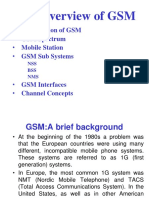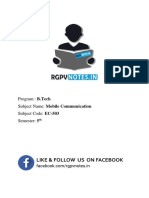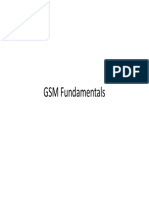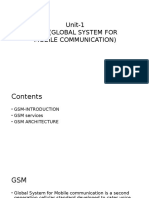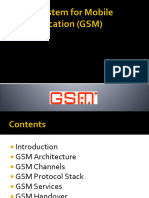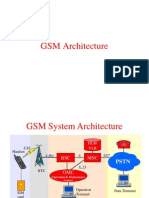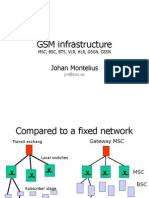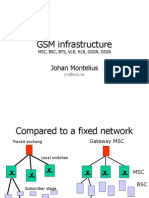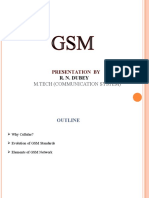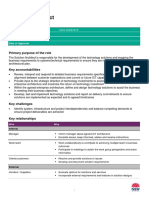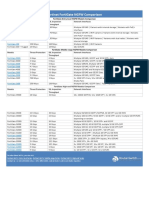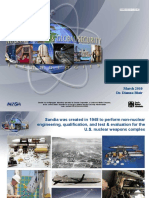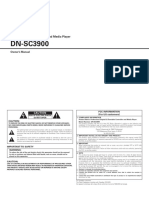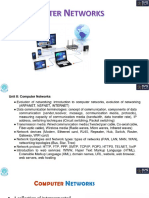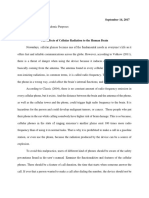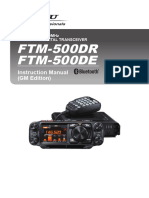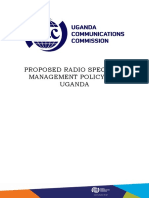EE5401 Cellular Mobile Communications
EE5401 Cellular Mobile Communications
GSM System
Global System for Mobile Communications
Introduced in 1991. Settings of standards under ETSI
(European Telecommunication Standards Institute)
2. Switching of GSM calls between external networks and
the BSCs.
3. Managing and providing external access to several
customer databases, such as
HLR : contains subscriber information (International
Mobile Subscriber Identity -IMSI) and location
information for each user who resides in the same city
as the MSC.
Services
- Telephone services
- Data services
- Short message paging
Network and Switching Subsystem (NSS) :
1. MSCs, Visitor Location Register (VLR), Home Location
Register (HLR), Authentication Center (AUC) and
Equipment Identity Register (EIR).
System Architecture : three major subsystems.
VLR : temporarily stores the IMSI and customer
information for each roaming subscriber who is visiting
the coverage area of a particular MSC. Once a roaming
mobile is logged in the VLR, the MSC sends the
necessary information to the visiting subscribers HLR
so that calls to the roaming mobile can be appropriately
routed over the PSTN by the roaming users HLR.
AUC : Strongly protected database which handles the
authentication and encryption keys for every single
subscriber in the HLR and VLR.
Radio Subsystem (Base Station Subsystem BSS):
1. Mobile stations (MS), Base Transceiver Station (BTS)
and the Base Station Controller (BSC)
2. Provides and manages radio transmission paths
between the MS and MSC.
3. One BSC controls up to several hundred BTSs.
Institute for Infocomm Research
188
National University of Singapore
Institute for Infocomm Research
189
National University of Singapore
�EE5401 Cellular Mobile Communications
EE5401 Cellular Mobile Communications
4. BSC performs handover for MS under the control of
same BSC.
Operation Support Subsystem (OSS)
1. Support the operation and maintenance of GSM and
allows system engineers to monitor, diagnose and
troubleshoot all aspects of the GSM system.
2.
Interacts with the other GSM subsystems.
3.
Charging and billing.
Interface
Location Management
TDMA/FDMA/FDD
Uses both TDMA and FDMA to transmit and recover
information.
Systems are FDD.
Institute for Infocomm Research
190
National University of Singapore
In cellular wireless networks, location management is
an important mechanism that enables the network to
discover the current attachment point of a MS so as to
facilitate successful information delivery.
For GSM networks, location information about MSs is
maintained by registration, whereby MSs update their
registration area(s) information with HLR and VLR, in
the event of changes in the registration areas(s).
Radio bandwidth normally needs to be reserved for
carrying location management traffic, which comprises
of two major components: paging and location update.
Paging is the process of searching for a MS in the
vicinity of its last-known location, typically in an area of
several cell sizes which is also known as a location area
(LA), so as to connect an incoming call.
Location update is the process undertaken by a MS to
inform the network of any changes in its current
location. Location updates typically occur each time a
MS crosses an LA boundary.
Institute for Infocomm Research
191
National University of Singapore
�EE5401 Cellular Mobile Communications
EE5401 Cellular Mobile Communications
HLR
PSTN
BSC1
MSC/
VLR
BSC3
Loca
tion U
pdate
Pa
gin
g
ing
Pag
Pagin
g
BSC2
MSC/
VLR
z It is also to be noted that both the location update
traffic and paging traffic are inversely proportional to
one another with respect to the size of the LA, i.e.
location update load decreases whilst paging load
increases for increasing sizes of LA, and vice versa.
z Paging has to be made at every cell of a LA.
LA 3
LA 1
Legends
:
10
LA 2
MSC/VLR Mobile-services Switching Center/ Visitor Location Register;
PSTN Public Switched Telephone Network;
HLR Home Location Register;
10
10
/ Moving/Still MSs;
BSC Base Station Controller;
Base Transceiver Station;
Current GSM Location Management Scheme. A service area comprises of 9 cells are
partitioned into 3 static LA, each having 4, 2 and 3 cells, respectively.
(10 + 10 + 10 + 10) 4
= 160
10
(20 + 20) 2
= 80
20
20
z The location management scheme of GSM Mobile is
given in IS-41. It is based on partitioning the cells
into static registration areas, known as location areas
(LAs).
z Location updates are to be performed when MSs
cross the partitioning of LA so that up-to-date
location information for each MS on is stored in the
respective HLR and VLR.
z Since the location information of each MS is tracked
on a resolution that is dependent on the size of the
LA, to facilitate a successful data delivery, all the
cells within the LA have to be paged concurrently.
Institute for Infocomm Research
192
National University of Singapore
Note: the number indicates the nomalized
paging traffic of the cell or cells cluster.
z Avoid setting the LA boundary at places when cell
crossing rate is high.
LA1
B = 10
LA2
BC = 20
C = 10
CB = 20
BA = 30
AB = 30
BD = 20
DB = 20 = 10
DC
DE = 20
AD = 20
A = 20
CD = 10 CE = 15
DA = 20
Institute for Infocomm Research
193
D = 20
EC = 15
ED = 20
F = 10
E
National University of Singapore
�EE5401 Cellular Mobile Communications
EE5401 Cellular Mobile Communications
Frequency domain
The frequency band for uplink (reverse) is 890-915 MHz,
downlink (forward) is 935-960 MHz.
- The bandwidth for the GSM system is 25MHz, which
provides 125 carriers uplink/downlink each having a
bandwidth of 200 kHz. The ARFCN (Absolute radio
frequency channel numbers) denotes a forward and
reverse channel pair which is separated in frequency by
45 MHz.
Base-to-mobile : Fu (n) = 890.2 + 0.2(n 1) MHz
Mobile-to-base : Fd (n) = Fu (n) + 45 MHz
- In practical implementations, a guard band of 100kHz is
provided at the upper and lower end of the GSM
spectrum, and only 124 (duplex) channels are
implemented.
There are a total of eight channels per carrier. Every
eighth timeslot on a TDMA channel, the user transmits
or receives his information.
A second frequency band from 1710-1785 MHz and
1805-1880 MHz (three times as much as primary 900
MHz) are also specified in 1990, a total of 374 duplex
channels DCS 1800
GSM has chosen the four-cell repeat pattern for the
frequency reuse cell sets. In most cases, each cell is
divided into 120-deg sectors, with three base transceiver
subsystems in each cell. Each base transceiver has a 120deg antenna.
- These 12 sectors (called cells in GSM system) share
the 124 channels.
Institute for Infocomm Research
194
National University of Singapore
Institute for Infocomm Research
195
National University of Singapore
�EE5401 Cellular Mobile Communications
EE5401 Cellular Mobile Communications
Time domain
RF carrier channel is time division multiple accessed by
users at different locations within a cell site.
- Frame duration is 4.615ms, and each frame consists of
8 time-slots.
- Each of the time-slot is a traffic channel having time
duration 0.577ms (3/5200s).
- The start of an uplink TDMA frame is delayed with
respect to downlink by three timeslots. Staggering
TDMA frames allows the same timeslot number (TN) to
be used in both directions.
Multiframe
26 frames (traffic or speech ~): Traffic CHannel (TCH),
Slow Associated Control CHannel (SACCH), Fast
Associated Control CHannel (FACCH).
51 frames (control ~) : Broadcast Common Control
(BCC), Stand Alone Dedicated Control Channels,..
Superframe : 51 traffic multiframes or 26 control
multiframes.
Hyperframe : 2048 superframes (3 hrs 28 min 52.76 s),
to support encryption with high security and frequency
hopping.
Institute for Infocomm Research
196
National University of Singapore
Institute for Infocomm Research
197
National University of Singapore
�EE5401 Cellular Mobile Communications
EE5401 Cellular Mobile Communications
Traffic Channel (TCH) :
- Traffic channels carry digitally encoded user speech or
user data. Have identical functions and formats on both
the forward and reverse link.
- Full rate : user data is contained within one TS per frame.
Half rate : user data is mapped onto the same time slot,
but is sent in alternate frames.
TCH/FS : Full rate speech, raw data sent at 13kbps,
with GSM channel coding 22.8kbps.
TCH/HS : Half rate speech, raw data sent at 6.5kbps,
with GSM channel coding 11.4kbps.
TCH/F9.6 : Full raw data rate 9.6kbps, send at
22.8kbps.
Physical Channel : specified by ARFCN and TN.
Logical Channel : is mapped onto the physical channel. E.g,
TCHs and control channels.
TCH/F4.8
TCH/F2.4
TCH/H4.8
TCH/H2.4
- TCH data may not be sent in TS0 within a TDMA frame
on certain ARFCNs which serve as the broadcast
station (control burst) for every frame. Furthermore,
frames of TCH data are broken up every thirteenth
frame by SACCH or idle frame.
Institute for Infocomm Research
198
National University of Singapore
Institute for Infocomm Research
199
National University of Singapore
�EE5401 Cellular Mobile Communications
EE5401 Cellular Mobile Communications
Traffic or speech multiframe
Control (Signaling) Channels : Three types :
Broadcast CHannel (BCH)
Common Control CHannel (CCCH)
Dedicated Control CHannel (DCCH)
Broadcast channel (BCH)
Only on downlink
T11
Three types of BCH
Broadcast control channel (BCCH)
1. Broadcast cell and network information
Control multiframe
2.
Cell and network identity
3.
List of channels in use
Frequency correction channel (FCCH)
1. Occupies TS0 of first frame
2.
Repeated every 10th frame within a control
channel multiframe
3.
Synchronization of local oscillator (radio
frequency) to base station oscillator.
Synchronization channel (SCH)
1. Broadcast in TS0 immediately following a FCCH
frame.
2.
Allows for frame synchronization
3.
Base station issues timing advancement commands.
Assume that the mobile 2 was allocated TS2 and he is close to the BS and
that mobile 1 has been allocated TS1 and is at the boundary of the cell site.
Due to higher distance resulting in large propagation delay, the transmitted
Institute for Infocomm Research
200
National University of Singapore
Institute for Infocomm Research
201
National University of Singapore
�EE5401 Cellular Mobile Communications
EE5401 Cellular Mobile Communications
signal of mobile 1 during TS1 reaches the BS later. If no action is taken, this
will overlap with other transmission slots.
The only solution is that the MS advances its emission relative to its
reception by a time corresponding to and from propagation delay. This
value is call the timing advance. The timing advance value can be computed
by the BTS and is then provided to the MS through signaling. The
maximum timing advance of 233us (6 bits data) is adequate for MS to be up
to 35 km from the BS, which is the maximum allowable cell radius of the
GSM systems.
Common control channel (CCCH)
Occupies TS0 of every control frame not used by BCH
or the Idle Frame.
3 different CCCH types
Paging channel (PCH)
1. Provides paging signals from base to mobiles.
2.
Notifies specific mobile of incoming call
Random access channel (RACH)
1. Uplink channel
2.
Used by mobiles to acknowledge page from PCH
3.
Used by mobiles to originate a call
Dedicated control channel (DCCH)
Bidirectional channels with same format and function
on uplink and downlink.
May exist in any time slot and on any radio channel
except TS0 of the control radio channel.
3 different DCCH are specified.
Stand-alone dedicated control channel (SDCCH)
1. Carries signaling data following the connection of
the mobile with BS.
2.
Intermediate and temporary channel for mobiles
while waiting for the BS to allocate a TCH channel.
3.
Ensures that mobile and base remains connected
during authentication and resource allocation.
4.
Maybe assigned their own physical channel or may
occupy TS0 of the BCH if there is low demand for
BCH or CCCH traffic.
Slow associated control channel (SACCH)
1. Always associated with a traffic channel
Access grant channel (AGCH)
1. Provides forward link communication to mobile.
2.
On downlink the SACCH carries power control and
timing advance instruction
2.
Specifies time slot, radio channel and dedicated
control channel.
3.
On uplink the SACCH carriers signal strength and
quality information
3.
AGCH is final CCCH message before mobile is
moved off the control channel.
4.
SACCH is allocated every 13th frame of a traffic
channel.
Institute for Infocomm Research
202
National University of Singapore
Institute for Infocomm Research
203
National University of Singapore
�EE5401 Cellular Mobile Communications
EE5401 Cellular Mobile Communications
Fast associated control channel (FACCH)
1. Carries urgent messages to the mobile, for example
handover.
2.
FACCH gains access by stealing frames from TCH
(e.g. data transmission slot are stolen).
Example : Mobile to PSTN GSM Set-up
- Synchronize to nearest BTS by monitoring BCH.
- Dial intended number
- Burst of RACH data
- BTS responds with AGCH message on CCCH and
assigns the mobile a new channel for SDCCH
connection.
- The MS listens to the SACCH frame to get timing
advance and power control info.
- MS sends authentication and validation requests.
- MS is instructed by the BTS over the SDCCH to retune
to new radio channel and TS for TCH assignment.
Time slot data bursts take on one of the 5 formats
according to the logical channel.
Mobile-Assisted handover
There are four purposes for handover
(1) rescue low-quality channel
(2)
recovering cochannel interference
(3)
traffic balancing among cells (avoid congestion or
load balancing) directed handover.
(4)
recovering in the event of failure of a control channel
A normal burst consists of 148 bits
Guardtime of 8.25 bits to avoid frame overlap.
Two batched of 57 bits are information bits
26 training bits for equalization.
Two stealing bits for FACCH
Institute for Infocomm Research
204
National University of Singapore
Institute for Infocomm Research
205
National University of Singapore
�EE5401 Cellular Mobile Communications
EE5401 Cellular Mobile Communications
There are three cases of handover,
(1) From one radio channel to another of the same BSC.
(2)
Between channel of different BSCs under the control
of the same MSC.
(3)
Between different MSCs in the same licensed
operator.
Speech coding
Between different licensed operators there are no
procedure.
There are two modes of handover :
(1) Synchronous : the old and new cells are
synchronized so that their TDMA timeslots start at
exactly the same time.
(2)
Asynchronous : this may lead to a longer
interruption of communication during handover
since MS has to re-initialize timing advance at the
new cell.
By repetitively monitoring the SCHs of all the
surrounding cells between transmission and reception of
traffic bursts, the MS can compute beforehand the timing
advances required for all surrounding cells. The MS is
then presynchronized with any such cell to which it may
be handed. This speeds up the handover process.
Institute for Infocomm Research
206
National University of Singapore
- The GSM speech coder is based on the Residually
Excited Linear Predictor (RELP)
- Enhanced by a long term predictor (LTP)
- The coder provides 260 speech codec bits for each
20ms, ie. The speech codec bit rate is 13 kbps.
- 40% average voice activity exploited by a
discontinuous transmission mode. A voice activity
detector (VAD) is used in the speech coder off the
transmitter for power saving.
- Half rate codec works at 6.5 kbps.
Institute for Infocomm Research
207
National University of Singapore
�EE5401 Cellular Mobile Communications
EE5401 Cellular Mobile Communications
For TCH/F.9.6,
Channel coding data channels
Full rate 22.8kbps :
The output bits of the speech coder are ordered into
groups for error protection, based upon their
significance in contributing to speech quality. Out of
the total 260 bits in a frame,
The most important 50 bits, called type Ia bits, have 3
parity check (CRC) bits added to them.
The next 132 bits along with the first 53 are
reordered and appended by 4 trailing zero bits, and
then encoded for error protection using a rate
convolutional encoder with constraint length K=5.
The least important 78 bits do not have any error
protection.
Institute for Infocomm Research
208
National University of Singapore
Institute for Infocomm Research
209
National University of Singapore
�EE5401 Cellular Mobile Communications
EE5401 Cellular Mobile Communications
Channel coding control channel
- GSM Control channel messages are defined to be 184 bits
long, and are encoded using a shortened binary cyclic fire
code, followed by a half-rate convolutional coder.
- The fire codes uses the generator polynomial
G5 ( x) = ( x 23 + 1)( x17 + x 3 + 1) = x 40 + x 26 + x 23 + x17 + x 3 + 1 w
hich produces 184 message bits, followed by 40 parity
bits.
- Four tail bits are added to clear the convolutional coder
which follows, yielding a 228 bits per block.
- This block is applied to a half-rate K=5 convolutional
code using the generator polynomials G0 ( x) = 1 + x3 + x 4
and G1( x) = 1 + x + x3 + x 4 (same as type Ia TCH). The
resulting 456 encoded bits are interleaved onto eight
consecutive frames in the same manner as TCH speech
data.
Institute for Infocomm Research
210
National University of Singapore
Modulation
0.3 GMSK.
The channel data rate of GSM is 270.833333 kbps
Interleaving
- To minimize the effect of sudden fades on the received
data, the total of 456 encoded bits within each 20 ms
speech frame or control message frame are broken
into eight 57 bit sub-blocks. These 8 subblocks which
make up a single speech frame are spread over eight
consecutive TCH time slots.
- If a burst is lost due to interference or fading,
interleaved data will help to spread the effect over a
few error-correction-frames. Hopefully channel coding
ensures that enough bits will still be received
correctly.
Institute for Infocomm Research
211
National University of Singapore
�EE5401 Cellular Mobile Communications
EE5401 Cellular Mobile Communications
Frequency hopping
- Under normal conditions, each data burst belonging to a
particular physical channel is transmitted using the
same carrier frequency.
- If users in a particular cell have severe multipath
problems, the cell may be defined as a hopping cell by
the network operator.
- Frequency hopping is carried out on a frame-by-frame
basis, thus hopping occurs at a maximum rate of 216.7
hops per second (1/0.004615 frame rate). As many as
64 different channels may be used before a hopping
sequence is repeated.
Institute for Infocomm Research
212
National University of Singapore
Institute for Infocomm Research
213
National University of Singapore
�EE5401 Cellular Mobile Communications
Verify the following:
Apparent bandwidth efficiency
GSM bit rate = 270.83 kbps, bandwidth = 200kHz
Bandwidth efficiency = 1.354 bs/Hz
The speech codec rate for each time slot = 456b/20ms
(=22.8kbps).
Each voice channel actually allocated for 270.83/8 =
33.854kbps.
Number of bits/slot = 33.854x4.615 = 156.25 bits
(148+8.25 guard time)
For each TDMA slot in each frame, 114 bits are
transmitted, and only 24 data frames per 26 frames are
transmitting, therefore the vocoder output rate =
114/0.004615 x 24/26 = 22.8kbps
However, of the 114 data bits in a slot, only 65 are raw
speech codec bits
Raw data rate = 22.8*65/114=13 kbps
Or 65 bits in 20ms = 13 kbps
Institute for Infocomm Research
214
National University of Singapore



